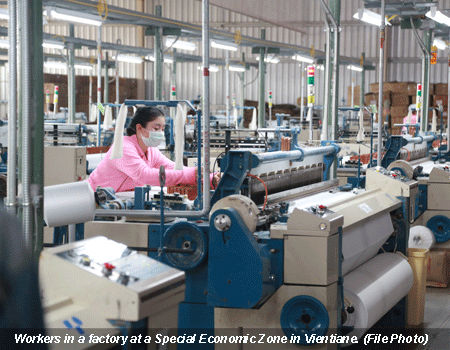Laos: Economists highlight opportunities, shortcomings of SEZs
Economists have noted that the establishment of special economic zones (SEZ) by the government has offered both opportunities and challenges for the country’s economic development.
Last week, the government called on the National Economic Research Institute –the country’s top think-tank – to carry out a study to identify these opportunities and shortcomings.
The institute will present its findings to the government with recommended measures to improve any shortcomings, and suggest where new SEZs might be established.
A senior economist and business advisor, Dr Mana Southichak, told Vientiane Times that SEZs, which offer tax and customs duty incentives, have been successful in attracting investment.
All the necessary infrastructure and facilities have been installed within the SEZs with a one-stop service system that can register new businesses within a single day.
“These factors have enabled businesses to start production more quickly,” said Dr Mana, who runs a business consulting company.
As of December last year, Laos had 12 specific and special economic zones, according to a report from the Ministry of Planning and Investment.
Dr Mana recommended that the government prioritise the establishment of SEZs, noting that Laos had created too many.
He feared that such a high number would be difficult to regulate properly.
The independent economist said some SEZs had been located too far outside towns, making it difficult to source sufficient labour.
“Workers need a social life. They need to shop and buy and so on after work. If there are no such services in the surrounding area they don’t want to be there,” he said.
“SEZs that focus on attracting service businesses do not need to be located far from urban centres as they are not a source of pollution, like industry.”
On the negative side, Dr Mana suggested that SEZs posed unfair competition for long-term businesses that had traded outside the zones before they were established. “Those operating inside SEZs enjoy the incentives, but those operating outside don’t,” Dr Mana said. “We should offer fair treatment and competition.”
Vice President of the Lao National Chamber of Commerce and Industry, Ms Valy Vetsaphong, recommended that the government vary the incentives for each SEZ.
“Each province has different specialities and potential but SEZs in the provinces utilise the same incentives. I personally disagree with this approach,” said Ms Valy, who is also a member of the National Assembly. “We need to study and specify what we want from each SEZ and consider the particular incentives that each zone might offer.”
The report by the Ministry of Planning and Investment showed that the 12 specific and special economic zones have attracted 350 Lao and overseas companies with total registered capital of US$8 billion. Of this, US$1.6 billion has been spent and 14,699 jobs have been created including 7,564 for Lao workers.
Source: http://www.vientianetimes.org.la/FreeContent/FreeConten_Economists.php


 English
English




